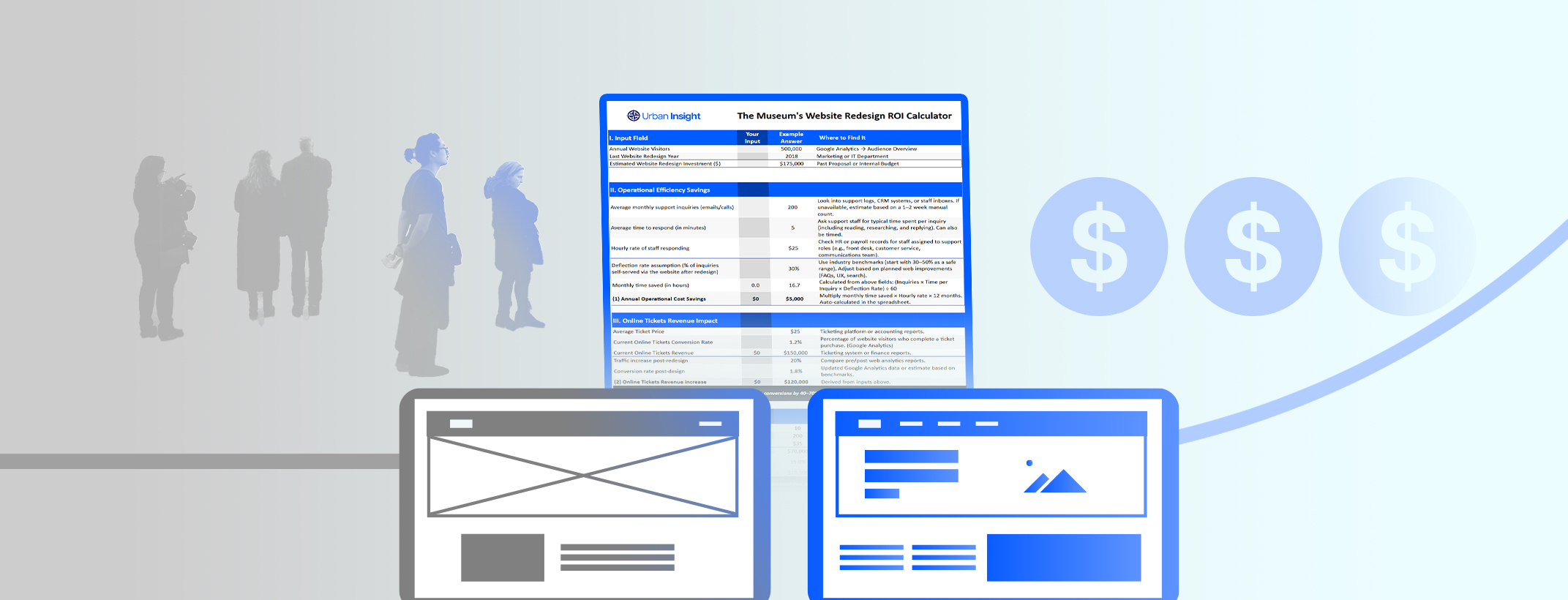You know your museum’s website needs work, but how do you prove its ROI to decision-makers?
You’ve seen the symptoms: ticket sales dipping, donation flows breaking down, staff tied up answering questions the website should’ve handled. But when you bring up the need for investment, the conversation with the board or CFO stalls. Why? Because traditional ROI calculators measure dollars in vs. dollars out. But for museums and cultural institutions, Return on Investment must be broader by encompassing mission fulfillment, community impact, and visitor engagement alongside revenue growth.
That’s where Urban Insight’s Free Museum Website ROI Calculator Tool comes in. It turns ambiguity into clarity. With just a few inputs, it quantifies not just how your website can pay for itself, but how it can multiply its impact across every revenue stream of your institution.
With just a few key metrics, this calculator estimates time and cost savings, projects revenue uplift across tickets, memberships, events, and donations, and gives you clear ROI numbers to confidently build your case.
1. Establish Your Baseline: Where Are You Starting From?
Every strategic journey begins with measurement, so your first step is to gather baseline data for key variables:
| Field | Where to Find It |
|---|---|
| Annual Website Visitors | Google Analytics → Audience Overview |
| Year of Last Redesign | Marketing or IT team records |
| Estimated Redesign Investment | Budget reports, proposal documents |
Why it matters:
If you haven’t redesigned since 2018 and still serve 500,000+ visitors per year, chances are your current UX, mobile responsiveness, and accessibility are costing you… and those costs compound if ignored.
2. Operational Efficiency Savings: Free Up Staff, Focus on Impact
A modern museum website should do more than showcase your exhibits, it should lighten your team’s load. Reducing the volume of repetitive support requests is one of the clearest and quickest ways to reclaim time and cut costs. Often overlooked in redesign projects, this operational efficiency can produce measurable returns with minimal effort.
Inputs you'll need:
- Support inquiries per month (e.g., 200)
- Time per inquiry (e.g., 5 minutes)
- Support staff hourly rate (e.g., $25/hr)
- Estimated self-service deflection: 30–50%
A simple example:
200 x 5 min = 1,000 minutes/month = ~16.7 hrs; at $25/hr, that’s $417 monthly or $5,000 annually.
With just a 30–50% reduction in support volume, you can redirect staff hours from routine tasks to mission-critical work; whether that’s fundraising, audience development, or planning new programs.
Tip: Start with simple, high-impact improvements: clearer navigation, integrated search, context-relevant FAQs, and on-site help tools. These can yield immediate deflection without major design overhauls.
Why this matters:
For resource-constrained cultural organizations, every minute saved is a minute you can reallocate toward your mission. Operational savings aren’t just about cutting costs, but about maximizing your team’s capacity to deliver impact.
3. Drive Ticket Sales: Optimize the Online Experience
Your website shouldn’t just inform, it should convert. For many museums, online ticketing is one of the most direct ways to generate revenue. Yet outdated designs, buried CTAs, and slow mobile performance often create friction right where it matters most: at the point of purchase.
Example Inputs:
- Average ticket price: $25
- Current conversion rate: 1.2%
- Post-redesign traffic increase (e.g., +20%)
- Post-redesign conversion increase (e.g., 1.8%)
In this model, those improvements can generate an extra $120,000 in additional revenue annually.
This isn't theoretical:
At LACMA, Urban Insight developed a high-performance museum ticketing system capable of handling thousands of users within seconds of ticket release. The redesign eliminated delays and reduced box office support emails to just 50, despite record-breaking ticket sales. Ticketing was fast, reliable, and scalable—exactly what patrons expect when buying for popular events.
How to implement:
Audit current traffic → Add a persistent ticket CTA → Track click-throughs → Optimize → Repeat.
Why this matters:
A well-designed ticketing flow does more than drive revenue. It sets the tone for your visitor’s experience. A seamless, mobile-first journey from homepage to confirmation screen boosts not only sales but also satisfaction. In an era where convenience defines loyalty, investing in online ticket UX is no longer optional, it’s a core revenue strategy.
4. Amplify Special Events & Programs Revenue
Special events are more than cultural highlights; they are also significant revenue drivers. From galas to film nights to behind-the-scenes tours, events connect communities and generate significant income. Yet, many museums still rely on outdated, clunky registration flows that frustrate users and limit turnout.
Example Inputs:
- Number of events per year: 10
- Average attendance: 200
- Average donation/ticket: $35
- Conversion uplift: +15%
With clearer calls-to-action, optimized mobile registration, and simplified ticket tiers, even a 15% bump in conversions can yield $10,500 or more annually. To further boost ROI, consider integrating upsell opportunities such as VIP access or donation add-ons.
Pro tip: Repurpose recorded events as on-demand content or snippets for newsletters, social, and donor engagement, thus extending the value of each event far beyond its runtime.
Why this matters:
By offering a digital experience that is effortless, swift, and informative, museums can increase visitor engagement and conversion to paid attendance. Great UX removes the friction between curiosity and commitment, unlocking new revenue from programs you’re already producing.
5. Unlock Membership / Donation Growth
Your museum’s most loyal supporters deserve more than a donate button buried in the footer. Memberships and donations are often underleveraged due to confusing flows, poor value communication, and lack of emotional connection. A well-structured website can reverse that.
Example Inputs:
- Membership/donation conversion rate: 1%
- Average donation: $75
- Post-redesign conversion increase: +40% (to 1.4%)
That 0.4% difference might seem small, but it’s significant. For institutions with strong traffic and average donor values, this can translate into $150,000 in additional annual revenue. More importantly, that’s sustainable funding from your most mission-aligned audiences.
To drive growth:
- Clearly outline member benefits (use visual comparisons if possible)
- Promote recurring giving options prominently
- Embed storytelling that shows how support directly fuels your mission
Example: Highlight real member stories, like patrons who helped fund landmark acquisitions or supported free programming. It turns donations into impact-driven investments.
Why this matters:
People don’t donate to websites, they donate to missions they care about. Your website is the first handshake, the first “thank you,” and the start of a longer journey. When you remove friction, express gratitude, and connect giving to outcomes, you build lasting relationships that go far beyond a single gift.
6. Expand Your ROI: Supplemental and Long‑Term Revenue Streams
The ROI Calculator goes beyond the usual suspects such as tickets, memberships, and donations. It invites you to think bigger. Cultural institutions are multifaceted. Beyond digital objectives, your website acts as a platform for real-world impact and long-term financial sustainability.
This section introduces supplemental revenue streams, those often ignored in standard budgeting but with the power to significantly shift your ROI trajectory.
| Revenue Stream | Measurement Formula |
|---|---|
| In-Person Ticket Sales | (New online visits × conversion %) × ticket price |
| Gift Shop & On-site Retail | (New visitors × average spend × purchase rate) |
| Education Program Participation | (# additional sign-ups × fee per program) |
| Sponsorships | (% uplift × annual sponsor revenue) |
| Virtual Exhibits / Licensing | (# of licenses × license fee/license) |
Practical Example:
Let’s say your redesigned website increases in-person attendance by just 5%. If that results in 25,000 extra visitors annually, and each spends $15 on tickets and $10 in the gift shop, you’re looking at an added $625,000 in supplemental revenue.
Why this matters:
While digital touchpoints are measurable, their ripple effect across your institution is often underestimated. Improved UX, clearer content, and better marketing alignment directly translate into tangible offline outcomes like increased school tours, higher store sales, and more corporate sponsorships.
Final Takeaway: More Than Just ROI—A Reframe of What Your Website Should Be
Urban Insight’s ROI Calculator isn’t just a spreadsheet. It’s a strategic lens that helps cultural institutions break free from treating their websites as sunk costs or static marketing tools. It reframes your website as a dynamic growth asset by quantifying how much it contributes to your mission, revenue, and reputation.
This isn’t about “doing better.” It’s about rethinking the category. Legacy thinking says: “Redesigns are expensive.” The new mindset, which Urban Insight’s museum website ROI calculator tool enables, is: “The cost of not redesigning is far greater.” That’s the insight that creates an “Aha!” moment for boards and fundraising leads.
With real metrics like payback period, ARPU (average revenue per user), and supplemental revenue potential, you’re not pitching fluff; instead, you’re presenting a board-ready business case backed by impact modeling. The calculator becomes both your internal alignment tool and your external fundraising weapon.
And by linking financial metrics directly to mission outcomes, like accessibility, engagement, trust, you’re not just defending a budget. You’re repositioning your website as a mission-critical asset, worthy of investment, iteration, and long-term vision.
Try the free museum website ROI calculator tool and lead your institution forward. This isn’t just about a redesign. It’s about setting a new standard for what cultural websites can and should do.


